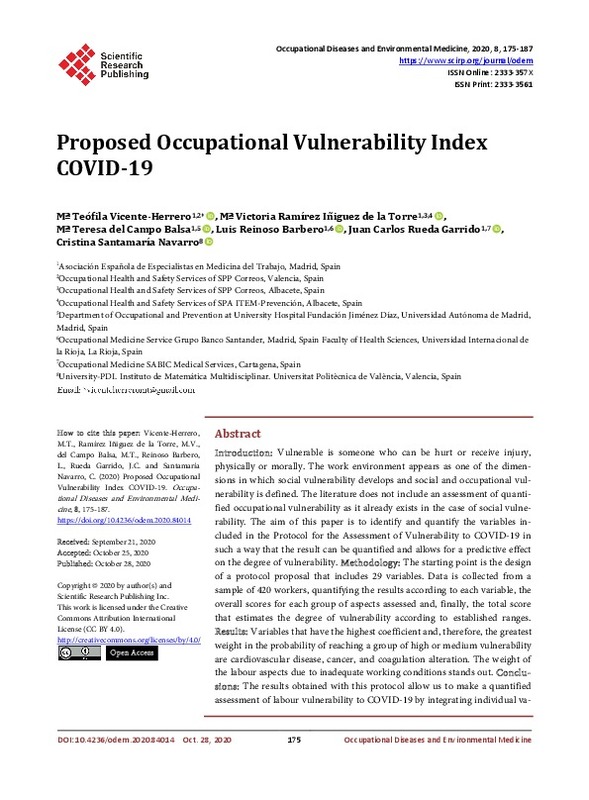JavaScript is disabled for your browser. Some features of this site may not work without it.
Buscar en RiuNet
Listar
Mi cuenta
Estadísticas
Ayuda RiuNet
Admin. UPV
Proposed Occupational Vulnerability Index COVID-19
Mostrar el registro sencillo del ítem
Ficheros en el ítem
| dc.contributor.author | Vicente-Herrero, Mª Teófila
|
es_ES |
| dc.contributor.author | Ramírez Íñiguez de la Torre, Mª Victoria
|
es_ES |
| dc.contributor.author | Del Campo Balsa, Mª Teresa
|
es_ES |
| dc.contributor.author | Reinoso Barbero, Luis
|
es_ES |
| dc.contributor.author | Rueda Garrido, Juan Carlos
|
es_ES |
| dc.contributor.author | Santamaria Navarro, Cristina
|
es_ES |
| dc.date.accessioned | 2021-02-25T04:49:00Z | |
| dc.date.available | 2021-02-25T04:49:00Z | |
| dc.date.issued | 2020-11 | es_ES |
| dc.identifier.uri | http://hdl.handle.net/10251/162355 | |
| dc.description.abstract | [EN] Introduction: Vulnerable is someone who can be hurt or receive injury, physically or morally. The work environment appears as one of the dimensions in which social vulnerability develops and social and occupational vulnerability is defined. The literature does not include an assessment of quantified occupational vulnerability as it already exists in the case of social vulnerability. The aim of this paper is to identify and quantify the variables included in the Protocol for the Assessment of Vulnerability to COVID-19 in such a way that the result can be quantified and allows for a predictive effect on the degree of vulnerability. Methodology: The starting point is the design of a protocol proposal that includes 29 variables. Data is collected from a sample of 420 workers, quantifying the results according to each variable, the overall scores for each group of aspects assessed and, finally, the total score that estimates the degree of vulnerability according to established ranges. Results: Variables that have the highest coefficient and, therefore, the greatest weight in the probability of reaching a group of high or medium vulnerability are cardiovascular disease, cancer, and coagulation alteration. The weight of the labour aspects due to inadequate working conditions stands out. Conclusions: The results obtained with this protocol allow us to make a quantified assessment of labour vulnerability to COVID-19 by integrating individual variables of the worker, his working conditions and the preventive actions of his company against COVID-19, and can be useful as an Occupational Vulnerability Index (OVI). | es_ES |
| dc.language | Inglés | es_ES |
| dc.publisher | Scientific Research Publishing | es_ES |
| dc.relation.ispartof | Occupational Diseases and Environmental Medicine (Online) | es_ES |
| dc.rights | Reconocimiento (by) | es_ES |
| dc.subject | COVID-19 | es_ES |
| dc.subject | Occupational vulnerability | es_ES |
| dc.subject | Occupational health | es_ES |
| dc.subject | Occupational medicine | es_ES |
| dc.subject.classification | MATEMATICA APLICADA | es_ES |
| dc.title | Proposed Occupational Vulnerability Index COVID-19 | es_ES |
| dc.type | Artículo | es_ES |
| dc.identifier.doi | 10.4236/odem.2020.84014 | es_ES |
| dc.rights.accessRights | Abierto | es_ES |
| dc.contributor.affiliation | Universitat Politècnica de València. Departamento de Matemática Aplicada - Departament de Matemàtica Aplicada | es_ES |
| dc.description.bibliographicCitation | Vicente-Herrero, MT.; Ramírez Íñiguez De La Torre, MV.; Del Campo Balsa, MT.; Reinoso Barbero, L.; Rueda Garrido, JC.; Santamaria Navarro, C. (2020). Proposed Occupational Vulnerability Index COVID-19. Occupational Diseases and Environmental Medicine (Online). 8(4):175-187. https://doi.org/10.4236/odem.2020.84014 | es_ES |
| dc.description.accrualMethod | S | es_ES |
| dc.relation.publisherversion | https://doi.org/10.4236/odem.2020.84014 | es_ES |
| dc.description.upvformatpinicio | 175 | es_ES |
| dc.description.upvformatpfin | 187 | es_ES |
| dc.type.version | info:eu-repo/semantics/publishedVersion | es_ES |
| dc.description.volume | 8 | es_ES |
| dc.description.issue | 4 | es_ES |
| dc.identifier.eissn | 2333-357X | es_ES |
| dc.relation.pasarela | S\423520 | es_ES |








